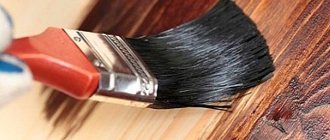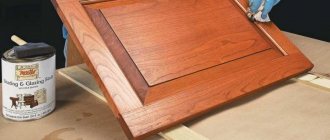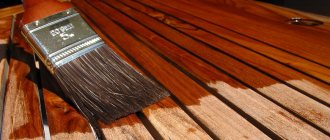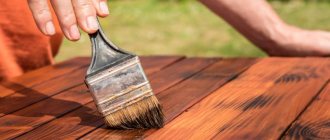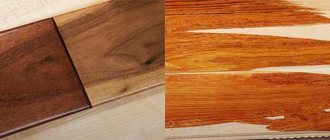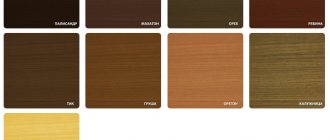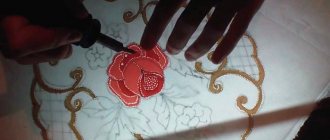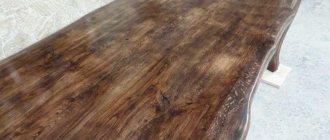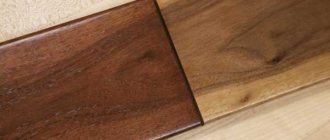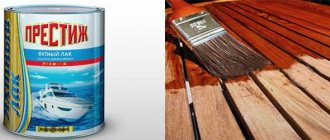Despite the emergence of various innovative materials, wood has been, remains and, most likely, will continue to be in demand in any construction. Well, furniture made from natural wood is considered the most prestigious. The demand for the material is explained by its unsurpassed environmental qualities, natural warmth, durability, and ability to create comfort.
Wood stain
Both in order to maximize the life of products and for decorative purposes, many special means are used, one of which is wood stain. This unique composition can not only transform the appearance of ordinary wood, but also reliably protect its structure from various pests and the effects of external adverse factors.
But to use stain, it is important to be able to understand the variety of possible compositions and the technology for their application.
General information about stains
Stain is a liquid composition, often dark in color, which can give wood various translucent shades, which allows you to radically change the appearance of the product, as well as protect the material from external destructive influences. Therefore, this means of processing wooden parts can be called multifunctional.
Stain can give wood different shades, radically changing the appearance of products
So, with the help of similar protective and decorative compositions, the following operations can be performed to change the appearance and characteristics of wood:
- It becomes possible to tint while preserving the textured pattern of the wood.
- A special-purpose stain is capable of bleaching wood - this is a necessary process during restoration work, when changing the color to a lighter shade, or when preparing the surface for applying varnish.
- Imitation of shades of elite expensive wood species is widely practiced.
- The stain has the property of deep penetration into the structure of the material, and its antiseptic qualities of the composition protect the wood from putrefactive processes and the destructive effects of wood-boring insects.
- The action of the stain is accompanied by strengthening the structure of the wood.
- An important quality is to give the material water-repellent properties.
- Any type of stain significantly extends the life of wooden products.
Using different shades of stain allows you to add visual volume to the wood grain.
- The stain is suitable for both interior and exterior work.
- The quite affordable cost of the material is also attractive - the price of stain is two, two and a half times lower than paint and varnish compositions similar in the created effect.
Different types of stain interact with wood differently, depending on the basis of their manufacture. Some of them penetrate deep into its structure, others create a protective film on the surface.
Choosing the grade of plywood for painting
When choosing plywood, you should rely on criteria such as:
- moisture resistance;
- degree of processing;
- variety.
This material is hygroscopic, that is, it is able to absorb and retain moisture. Therefore, manufacturers try to reduce this disadvantage to a minimum and produce varieties with moisture-resistant properties:
- FC is a moisture-resistant material for the production of furniture and interior decoration.
- FSF - sheets with increased stability, are used for roofing in the construction of objects where mechanical loads are expected.
- FOF - laminated plywood, thanks to a special surface coating, has a high level of moisture resistance.
- Bakelite veneer sheets - in addition to the protective coating on the surface, are reinforced with a fiberglass reinforcing mesh.
According to the degree of processing - grinding, the material is divided into the following groups:
- Ш1 - the surface is polished on one side.
- Ш2 - processing on both sides.
- NS - no grinding.
Grade is an indicator of the appearance of the surface of the material, which indicates the extent of preparatory work before painting.
- Elite - the best in quality, there are no knots, cracks, wormholes, preparation before pigmentation is minimal.
- First grade - the surface quality is slightly inferior to the elite group; a maximum of 5 knots are allowed, measuring 1-1.5 cm per 1 sq. m.
- The second and third grades are distinguished by the presence of minor damage (scratches, dents), knots, cracks up to 20 cm. The difference between these groups is only in the amount of damage.
- The fourth grade is not inferior in quality indicators, but the surface may have any defects. This variety requires lengthy and thorough preparation before painting.
Thanks to this classification, before purchasing materials, you can estimate all the necessary costs in terms of time and finances.
Varieties of stain compositions
Stains are made on various bases - it can be water, alcohol, oil, wax. Each of the listed options has its own specifics.
Water based stain
The most common and widely used type of this material is water-based stain. It is produced in the form of ready-made solutions, concentrates or powders, which are diluted immediately before use.
Water based stain.
The composition made from powder, after diluting it, must be filtered before application to avoid undissolved pigment particles getting onto the surface of the wood. They will interfere with the even application of the composition, which will make the surface color uneven. The advantage of the powder version is that it can be used to make a solution of different concentrations, that is, darker or lighter.
The liquid solution is sold in containers of various sizes. This option is more convenient because it is ready to use and does not require preliminary preparation. However, it has a certain shade that is difficult to change.
Water-based stain has an affordable price, is economical to apply and does not require special skills to use. In addition, such a composition can be called an environmentally friendly material, since it does not have an unpleasant odor and does not contain harmful substances. Therefore, water-soluble stains are ideal for interior work. Complete drying of the applied solution occurs 12 hours after application.
When purchasing a water-based stain, you must take into account that it is not capable of radically changing the color of the material. She can only make it a tone darker and richer. The solution will have to be applied in several layers.
In addition, one more feature of the effect of water stain on wood should be taken into account. By impregnating the fibers of the material, the solution slightly lifts its fibers, due to this effect a textured pattern stands out. However, such exposure significantly reduces the service life of wooden parts. To minimize this negative impact, before applying stain, the surface is first treated with plain water, left for a day, and then sanded with sandpaper. Only after this can you start working with the decorating composition.
Varnishing will give the surface a matte or glossy shine.
After the stained product has completely dried, it is recommended to apply a water-based varnish to its tinted surface.
Prices for wood stain
wood stain
Alcohol stains
Alcohol-based stains are produced in the same way as water-based ones, in dry and dissolved form. If the composition is purchased in powder form, it is diluted with ethyl alcohol.
The big advantage of this material is its quick drying, so quite often alcohol stains are used for external work. The solution can also be used for indoor work, however, it must be taken into account that it has a strong, specific odor. Therefore, during the period of its application, the room should be provided with effective ventilation.
Liquid solution of alcohol stain, ready for use
Quick drying, by the way, can be regarded as both an advantage and a disadvantage of the alcohol composition. The fact is that it will be difficult to apply it evenly with a brush. Therefore, most often the treatment of wood with such a stain is carried out using a spray gun.
Applying alcohol-based stain using a spray gun.
Alcohol solutions quickly and deeply penetrate the wood structure, which provides high-quality protection of the material from moisture and ultraviolet exposure.
Alcohol-based stains are available in a wide variety of shades. However, this material is not as popular as water-based solutions, since working with them requires some experience and suitable equipment. And the price is still significantly higher.
Prices for alcohol stain
alcohol stain
Oil stains
Oil compositions of this type of action, that is, those that fit the definition of stains, are produced on the basis of linseed oil. And if it is necessary to dilute the working composition, white spirit is usually used. Dilution of thick compositions allows you to obtain solutions of different shades.
Oil based stain.
When applied to wood, this type of treatment composition penetrates well into its structure without leaving streaks on the surface. Painting wood with oil stains is done using a brush. Thanks to this impregnation, the product receives excellent protection from moisture and damage by insects.
The disadvantages of the oil composition include its very long drying time. Well, and a considerable cost too.
Prices for oil stain
oil stain
Oil-wax stains
Wax and oil-wax stains are made from natural materials and are environmentally friendly compositions, which naturally affects their cost, which exceeds the price of any other analogues.
An oil-based stain containing natural wax.
But at the same time, oil-wax compositions have enough advantages to give them preference, despite the high cost:
- The stain does not saturate the wood with moisture.
- The composition can be used not only for tinting wood, but also for its restoration, as it can correct minor surface errors.
- By adding dye to such solutions, you can easily change their shade.
- The solutions are applied to the wood in a thin, even layer and create a protective film on the surface.
- Oil-wax stains are resistant to ultraviolet rays, so they retain their original color much longer than other protective and decorative coatings.
- No additional varnish coating is required on top of the layer of this material.
The disadvantage of the oil-wax composition is the long drying time.
Stain-gel
Only stain-gels from foreign manufacturers are presented on the Russian market. The compositions have a thick consistency, so they are applied to the surface using special tampons. They are especially suitable for coating softwood, as they can harden the surface when dry.
The compositions are used for both internal and external work. Moreover, they are used for tinting any products and surfaces, including floors subject to heavy traffic.
A gel-like composition that works like a wood stain
The advantages of stain-gels include the following:
- The compositions give surfaces rich, saturated shades that highlight the natural beauty of wood.
- Unlike liquid solutions, the gel does not drip when applied to vertical surfaces and is evenly distributed over the surface.
- The hiding power of gels is twice as high as that of liquid solutions.
- When applied, the composition does not lift wood fibers.
- The gel can be used to create a textured pattern of natural wood on steel surfaces.
- The composition dries quite quickly. So, if it is necessary to apply a second layer, this can be done within two hours after applying the first.
The disadvantages include the high cost of the material and the assortment that is not yet wide enough. True, its diversity is still constantly growing.
Acrylic stain
Acrylic stain is made on the basis of acrylic resins and has the consistency of an emulsion. The mass is easily applied to wooden surfaces and penetrates deeply into the structure of the base.
Acrylic stains are presented in a fairly wide variety of shades, so it is possible to choose the appropriate color for a particular product.
Acrylic stain, which simultaneously provides antiseptic treatment of wood.
The advantages of this material include the following qualities:
- The antiseptic properties of the emulsion help protect wood from mold and other biological damage, including insects.
- The material is resistant to ultraviolet rays, as well as moisture, and reliably protects wood from their negative effects.
- Acrylic stains do not have unpleasant odors, do not contain toxic substances, and are fireproof.
- The material is harmless to human health and the environment.
- The emulsion has excellent adhesion to any wooden surface, including plywood.
- The solution penetrates deeply into the structure of the material.
One of the disadvantages is the high cost of high-quality emulsion acrylic stain.
Application rules
The wax emulsion is applied with a brush.
In conclusion, we would like to give some practical tips on applying stain to a surface. In each specific case, the instructions will have their own characteristics, but we will try to consider the most general points.
So, let's start by reminding you: stain is not paint, it must be absorbed into the pores to a certain depth, so the most favorable conditions for this should be created.
Basic application methods.
First of all, you should prepare the surface. It must be cleaned of any coatings, dirt and dust, and also treated with fine abrasive sandpaper to open the pores. It must be remembered that they will be open for no longer than two hours, so grinding must be done immediately before starting work.
You should also prepare the stain. It can be heated to a temperature of 40 - 50 ˚С, so it will be more fluid and better absorbed into the material
It is especially important to ensure the permeability of dense wood species; for this, the composition can be diluted with water, and if the wood stain is non-aqueous, with a solvent
Applying the solution with a brush.
When working with aqueous solutions, in order to avoid raising the fibers, which is fraught with loss of protection from moisture, the surface is pre-wetted, and then wait a while and sand it with sandpaper. This allows you to neutralize the unwanted effect.
When applying the material with a brush, work along the grain lines. Thick formulations and gels should be rubbed in thoroughly; for this you can use cotton swabs wrapped in cotton cloth or gauze.
Oil and nitro stains are quite toxic, so when working with them it is better to ventilate the room or go outside. Gloves and eye glasses are also a good idea.
To create the effect of aged wood, the stain is first applied liberally and then wiped off with a cloth. This way the texture becomes especially expressive and varied. For this work, you should use oil or wax.
Alcohol compounds are poisonous.
Variety of stain shades
The range of stain shades is so wide that it is impossible to cover it completely in one article. It can only be noted that each manufacturer develops its own color scheme for these declarative and protective materials. The most popular tones may be common to them, and even then they may differ from each other.
Color palette of universal stain.
There are several of the most popular shades that are chosen for coating wooden products intended for interiors or outdoor use. And to simplify the visual assessment of popular stain shades, you can refer to the table below:
| Illustration | Brief description of the shade |
| White stain is very popular today for coating wooden furniture, as well as facing materials for interior surfaces. As you know, light colors expand the space and add light to the room. In order to turn the usual color of wood into “bleached oak”, it is necessary to use two types of stain: - the first layer is a white aqueous solution; — the second layer is an oil-wax composition, which is applied after the previous one has completely dried. The oil composition will close the pores, giving them a darker color, and thereby revealing the natural texture of the wood. | |
| Black solutions are actively used when decorating door frames and panels. They are also used when creating combined compositions, or in order to obtain a certain effect. When choosing a black stain to decorate a particular product or surface, it is better to give preference to an oil composition, which can even be used to cover a wooden floor. Oil stains are resistant to abrasion, so they will last a long time without unnecessary need for restoration work. | |
| "Wenge" is the name of a tropical wood that is dark brown in color with black veins and inclusions. This design option for wooden surfaces is perfect for furniture accessories, doors, panels, floors, etc. The noble shade of “wenge” is suitable for classic interiors, giving them respectability and special charm. | |
| If the wood needs to be given a distinctly “rich” look, then for this purpose it is worth choosing the color “mahogany”, which contains red-brown shades. This type of stain, just like wenge, can be used for any surfaces and interior furniture accessories, naturally, if it is decorated in one of the classic or modern styles. | |
| “Ebony” is the name given to a stain that includes shades of silver-gray, blue, black and similar tones. To achieve the desired effect, it is recommended to use this color on hardwood, which should be thoroughly polished before applying the stain. This type of stain can be used to treat wooden flooring, lining installed in the form of panels, as well as individual pieces of furniture. | |
| There are quite a lot of blue and blue shades of stain on sale. The example shown features a color called “behandle”. Blue tones are usually used to cover surfaces and furniture in children's rooms, and sometimes in kitchens. The main advantage of the blue color is the ability to give the interior a certain expression, especially in cases where a good combination is chosen for it. For example, dark blue color looks harmonious with gray, blue, yellow shades, as well as white. Lighter blue tones can be combined with white and gray. | |
| “Mahogany” is a “lighter” option compared to “wenge” and “mahogany” and it may not look so rich and respectable. However, it is precisely thanks to the light tone that design elements of this color will not burden the interior. It is necessary not to forget that red color is considered “aggressive”, so you should not use it in the bedroom, and also unnecessarily overload other rooms with it. The best choice would be to use this color as an accent, for example covering a wooden table with it. | |
| The gray color of the stain must be used very delicately. He is quite capable of adding individuality and neatness to the interior, but sometimes he can also bring gloom and despondency into it. The right solution would be to find the perfect color combination with other design items, since gray shades require a bright revitalization. | |
| The color swatch shown in the illustration is called “spruce green.” Green shades help relax the eyes after a busy day at work, so they can be used to decorate wooden elements in a bedroom or living room. However, it must be remembered that “greenery” should also go well with the overall interior design. This color is also suitable for a children's room, especially if a restless child lives in it. | |
| “Walnut” - this color is popular for bedrooms, living rooms, hallways and corridors. It can be used to cover absolutely any wooden interior elements, with the possible exception of the ceiling surface. This is a light but noble shade that very favorably emphasizes the textured pattern of wood. |
How to make stain yourself?
Some craftsmen prefer to make wood tinting solutions using their own recipes. Below we will present several options that are quite accessible for making at home.
In order to achieve a certain shade of wood, various plant and chemical compounds are used.
1. To give the wood one of the brown shades, thick infusions of tea or coffee can be used.
Strongly brewed tea contains tannins that can change the color of light wood.
- To make a stain from tea, a thick brew is made from it, which is filtered after cooling. The composition is then applied to the wood, and thanks to the tannins contained in the tea, the wood acquires one of the many brown shades. The color saturation will depend on the concentration of the tea leaves made.
- Coffee is used in much the same way as tea. Its ground grains are brewed, infused and filtered. The intensity of the color will depend on the strength of the prepared solution. In order to achieve a certain shade of wood, a small amount of soda is sometimes added to coffee. The proportions of the ingredients are 1:4, that is, 4 parts coffee to 1 part soda.
2. Walnut shells and partitions, crushed, boiled and strained, also provide a solution that will give the wood a brown tint. Sometimes soda is added to the composition. If it is necessary to achieve a red-brown tint, then potassium dichromate should be added to the decoction. 3. In order to achieve a reddish tint to the wood, an infusion of larch bark or onion peel is used.
Larch bark is an excellent natural ingredient for making wood stain, which gives wood a reddish tint.
4. Black stain can be obtained by using a decoction made from the bark of alder, willow, oak, and walnut shells to treat wood. All of the above ingredients are poured with water, brought to a boil, after which ½ teaspoon of soda is added to the broth, and it should boil for another 10 minutes.
To obtain the “ebony” effect, the wood is coated with a tincture made from acetic acid, to which metal elements, such as nails, are added. This solution should be infused in a dark place for seven days.
Buckthorn berries and bark are used to tint light wood.
5. To obtain a golden hue, use a decoction of buckthorn berries. 6. The gray color of wood can be obtained by applying acetic acid to it. 7. Wood fibers will turn cherry when a thick solution of magnesium permanganate is applied to them. To make it you will need 50 grams. powder, which are added to one liter of heated water. 8. Greenish tints of wood can be obtained by using a mixture of vinegar with 50 grams of copper sulfate, which should be boiled for 15 minutes before application. 9. Blue tones are achieved by mixing red elderberries with baking soda. 10. The tree acquires a bright orange color when tinted with a decoction made from poplar shoots - 150 grams of raw material per liter of water. The mixture must be boiled for an hour, then it is filtered and left in the light - after which it turns orange. 11. If you add alum to any of the above solutions, you can get a more intense color of the coating. 12. Heated cotton oil can give wood a dark shade and highlight its textured pattern. In addition, this composition will significantly strengthen the material. 13. As mentioned above, whitening compositions, which can also be made at home, have become very popular. A remarkable fact is that when applying bleaching compounds to different types of wood, you can get the most unexpected shades. For example, walnut has natural purple hues, so when a bleaching solution is applied, it may take on a pinkish or even bright scarlet color. The shade will depend on the amount of natural pigment in the wood. When apple wood is coated with bleach, it will acquire a delicate ivory shade.
Next, several whitening recipes will be given.
Oxalic acid is sold in the form of crystals.
- Oxalic acid. You only need 5 grams per 100 milliliters of water. This composition is used to bleach light wood. This solution is not suitable for dark wood, as it can leave unsightly stains. After application and obtaining the desired effect, the wood should be washed with a composition that includes 15 grams of lime and 3 grams of soda per 100 milliliters of water.
- Hydrogen peroxide is used to bleach all types of wood, except rosewood and oak. There is no need to rinse the wood after applying this substance.
Making homemade stain is not at all difficult, but in order to achieve the desired shade you will have to experiment, since it is unlikely that you will be able to “hit the mark” right away, that is, get the desired tone. Having prepared the solution and remembering its proportions, the stain is applied to a small area of wood and wait until it dries until the final effect appears. If the shade turns out to be too light, you need to apply a second layer of the solution.
When performing experiments, precautions should be taken, especially if the recipes use toxic substances or acids. It is recommended to work with them in a well-ventilated area or, if possible, outside. You should not neglect skin and eye protection - gloves and goggles.
For the final exterior coating of stained wood, it is best not to use polyurethane varnishes, as they may curdle. Therefore, in this case, nitro varnishes are more widely used.
Video: Demonstration of the recipe and process for preparing stain at home
Practical advice
When painting plywood and subsequent use, you should follow the following recommendations.
- Rollers are often used for work. You should choose foam rollers, since fur rollers leave lint, which is very difficult to get rid of.
- If plywood is painted or varnished twice, it is important to ensure that the previous layer dries completely.
- Edges and curved elements are painted with a brush.
- Painted dry surfaces can be cleaned with soft sponges using soap compounds.
- Glossy surfaces are periodically wiped with a mixture of water, vinegar and lemon juice to restore shine.
- Do not use abrasives or hard brushes to clean painted plywood.
Technique for highlighting wood patterns
The use of stain for tinting wood is often directly related to emphasizing its natural pattern. For this, a special technique is used, called brushing (from the English word “brush” - “brush”). By using this technology, you can not only highlight the design with color, but also give it a beautiful relief.
The technology is possible to implement due to the existing difference in the hardness of the wood layers. If you look at a cross section of a tree, you can see a pattern formed by annual rings, consisting of fibers with different strength characteristics. Their main difference is their different densities - among the hard layers there are softer ones that are easy to process.
An example of a wooden part that has been processed using the brushing method.
The natural relief appears when the top layer of soft wood fibers is removed, due to which it becomes decorative. The stain used in this method of transforming the material contributes to the color highlighting of the structural pattern.
To use this technique in combination with tinting, any type of wood with thick or thin longitudinal fibers is suitable. Wood structured in this way is used for the manufacture of furniture, flooring, paneling, as well as for the manufacture of individual elements of decorative finishing, for example, framing cladding made of other materials.
Brushing can be called the simplest and most affordable method of giving wood individuality and decorativeness, as well as, if necessary, artificially “aging” the material. In this case, the depth of the relief can be distinguished in different ways. For example, boards intended for flooring are not deeply processed, since dust and dirt will collect in the recesses. However, the pattern can be distinguished visually by using one or more stain solutions.
Brushed and stained boards.
It is quite possible to carry out the process of such wood decoration at home. This will require some simple hand tools and some common power tools.
Tools and devices that can be used to create structural relief on the surface of wood.
So, to give the tree a certain look, you need to prepare the following tools and materials:
- Wood stains for tinting, as well as brushes, rollers or spray guns. The tool is selected depending on the consistency of the tinting composition.
- Hand-held metal brushes of varying hardness, or a grinder (electric drill, screwdriver) with a metal brush attachment. These instruments are used to remove softer fibers.
- Sandpaper of different grain sizes - for rough cleaning and fine polishing of the relief.
- Varnish for the final coating of the finished product.
Sanding the board with a sander and a wire brush.
Everything is fine, but the master works with his bare hands. Don’t follow his example - don’t neglect your protective equipment! It should be noted that with a small sander at your disposal, the work can be done much faster, and the cleaning of the wood will be more uniform. This is due to the fact that the device operates at a constant speed.
For grinders, special narrow or wide brush attachments are provided, made of metal, polymers with an abrasive applied to it, as well as hair or sisal. By adhering to the step-by-step work, using such a power tool, you can make ideally decorated parts or blanks from wood for installing interior cladding.
The work is carried out in the following order:
Samples of blanks coated with a double layer of stain and brushed.
- If you plan to show the structural design in color, then the first step is to whiten the board or other wooden piece using one of the types of stain. After this, you should wait until the material dries completely - it should form a dense layer or completely saturate the wood several millimeters deep.
- A colored layer of stain is applied on top of the bleached workpiece so that it completely covers the primary one. The second layer of solution must also dry well, otherwise the wood will produce burrs during processing.
Defects and their elimination
Staining wooden furniture must be done extremely carefully, otherwise there is a high risk of defects forming that are quite difficult to eliminate. But if you know how to get rid of them correctly, then there shouldn’t be any problems.
The main defect is the formation of streaks. They arise as a result of applying a large amount of the mixture and its subsequent rapid drying. In this case, it is necessary to remove the layer of impregnation applied to the wood, then apply a new layer on it, which will soften it, and then remove excess impregnation with a rag.
After the wood stain has completely dried, it can be removed using paint solvents. Before this, the top layer is removed with sandpaper or a plane, since the solvent is not able to remove all the pigment.
You can choose a special remover that will remove the excess layer of coating impregnation from the wood. You can use a hair dryer in combination with a scraper and brush - sometimes this is better than washing.
The most difficult defect is spotting of the product. To remove it, the painted area is treated with a plane (this defect is not washed off with a solvent). In plywood, all face veneer must be removed. To avoid staining, it is better to use a gel stain or first apply a test layer on an unwanted piece of wood to see how the coating behaves on the desired surface. It is worth remembering that the impregnation must be stored in a place away from children.
